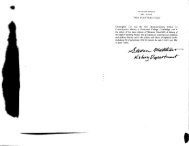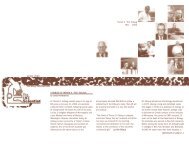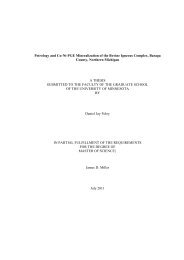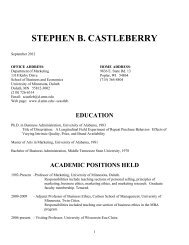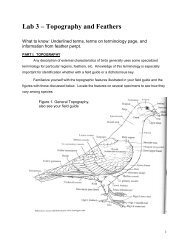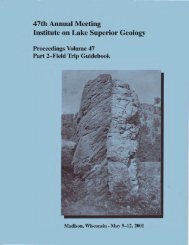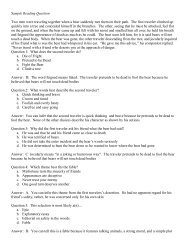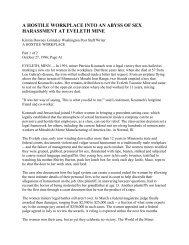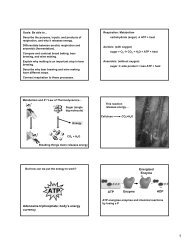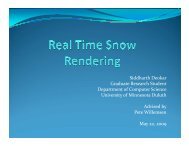Program, Abstracts, and Guidebooks - University of Minnesota Duluth
Program, Abstracts, and Guidebooks - University of Minnesota Duluth
Program, Abstracts, and Guidebooks - University of Minnesota Duluth
Create successful ePaper yourself
Turn your PDF publications into a flip-book with our unique Google optimized e-Paper software.
-12-<br />
THE STRUCTURE OF THE NORTHERN LAKE OF THE WOODS GREENSTONE BELT,<br />
A DEFORNATIONAL W)SAIC.<br />
W. C. BRISBIN<br />
<strong>University</strong> <strong>of</strong> Manitoba<br />
ABSTRACT<br />
The structure <strong>of</strong> the northern portion <strong>of</strong> the Lake <strong>of</strong> the Woods<br />
greenstone belt may be described as a complex mosaic, consisting <strong>of</strong><br />
the effects <strong>of</strong> several deformation events, each <strong>of</strong> which has been<br />
developed spatially to differing degrees. Individual domains, within<br />
the mosaic, may show strain effects <strong>of</strong> one, or more, <strong>of</strong> three widespread<br />
<strong>and</strong> dominant tectonic events, the chronology <strong>and</strong> tectonic styles <strong>of</strong><br />
which are remarkably persistent.<br />
The earliest deformational period is manifest by folds in layering<br />
which are seldom unaffected by later events. Where structural overprinting<br />
is poorly developed the evidence suggests that these folds<br />
were developed by a flexural mechanism, under conditions <strong>of</strong> low mean<br />
ductility, where layer contacts were active. These folds are interpreted<br />
as having developed post lithification <strong>and</strong> prior to any major metamorphic<br />
event.<br />
Large areas <strong>of</strong> the greenstone belt show evidence <strong>of</strong> a second<br />
deformational event which has led to the development <strong>of</strong> a penetrative<br />
<strong>and</strong> tectonically active foliation. Differential movements, either<br />
leading to, or on, the foliation have resulted in passive folds which,<br />
in many areas, have been superimposed on earlier sets. Evidence on,<br />
all scales, from deformed clasts to deformed early plutons, indicates<br />
that strain during this event was accomplished by a combination <strong>of</strong><br />
simple shear <strong>and</strong> differential pure shear. The directions <strong>of</strong> extensive<br />
strain <strong>and</strong> simple shear movements during this event had strong vertical<br />
components; the strain effects <strong>of</strong> this event are linked to the reorganization<br />
<strong>of</strong> upper crustal masses which accompanied the emplacement<br />
<strong>of</strong> the numerous granitic diapirs which have intruded the greenstone.<br />
The third period <strong>of</strong> deformation is portrayed best in many <strong>of</strong> the<br />
areas where the second period penetrative foliation occurs. The earlier<br />
foliation served as an active surface for the development <strong>of</strong> flexural<br />
folds on all scales; from microscopic crenulations, to mesoscopic kink<br />
b<strong>and</strong>s, to major folds with structural relief <strong>of</strong> several thous<strong>and</strong> feet.<br />
Movement directions during this event were variable within, <strong>and</strong> between,<br />
domains, suggesting a wide variety <strong>of</strong> late stress conditions both<br />
temporally <strong>and</strong> spatially.




